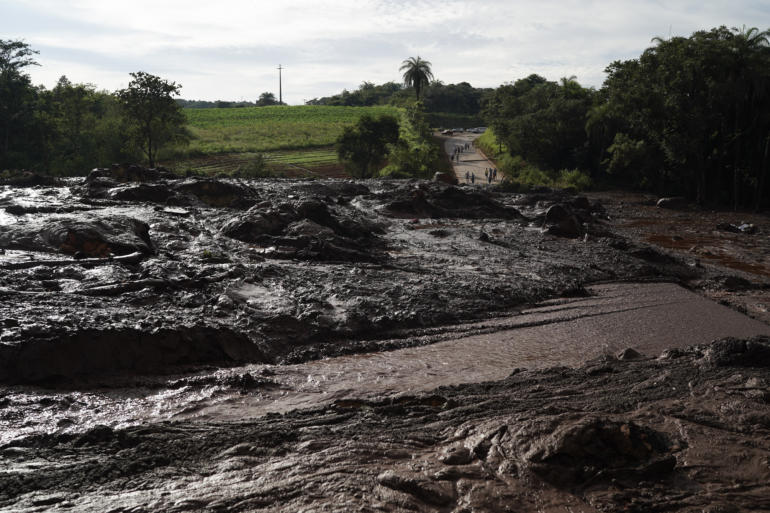Rescuers in helicopters on Saturday searched for survivors while firefighters dug through mud in a huge area in southeastern Brazil buried by the collapse of dam holding back mine waste, with at least nine people dead and up to 300 missing.
More than 24 hours since the disaster happened, finding many more survivors was looking increasingly unlikely.
CGTN’s Paulo Cabral reports.
“Most likely, from now on we are mostly going to be recovering bodies,” said Romeu Zema, the governor of the state of Minas Gerais, adding that those responsible “would be punished.”
Daily Folha de S.Paulo reported Saturday that the dam’s mining complex was issued an expedited license to expand in December due to “decreased risk.”
Preservation groups in the area say the approval was unlawful.
Lt. Pedro Aihara, a spokesman for state firefighters, told reporters that they had found a bus they believed could be filled with bodies. However, accessing the bus buried in yards (meters) of mud was proving difficult.
“We need a special machine to access the structure and recover victims,” Aihara said. “The number of dead is going to go up.”
Still, there were some signs of hope. Authorities announced they had found 43 more people alive Saturday, though the number missing was still at 300.
Firefighters distributed to news outlets lists of people who had been rescued or accounted for. But there were still scores of families in the city desperately awaiting word on their loved ones.
For many, hope was fading to anguish.
“I don’t think he is alive,” said Joao Bosco, speaking of his cousin, Jorge Luis Ferreira, who worked for Brazilian mining company Vale. “Right now I can only hope for a miracle of God.”
Vale workers were eating lunch Friday afternoon when the dam collapsed, unleashing a sea of reddish-brown mud that knocked over and buried several structures of the company and surrounding areas.
The status of the workers and others in the city of Brumadinho was unknown Saturday, but the level of devastation quickly led President Jair Bolsonaro and other officials to describe it as a “tragedy.”
Ten bodies had been recovered by Saturday, according to a statement from the Minas Gerais governor’s office. But the fear was that there would be many more as rescue and recovery teams dug through feet of mud.
The rivers of mining waste raised fears of widespread contamination.
According to Vale’s website, the waste, often called tailings, is composed mostly of sand and is non-toxic. However, a UN report found that the waste from the 2015 disaster “contained high levels of toxic heavy metals.”
Vale CEO Fabio Schvartsman said he did not know what caused the collapse. About 300 employees were working when it happened. About 100 had been accounted for, and rescue efforts were underway to determine what had happened to the others.
“The principal victims were our own workers,” Schvartsman told a news conference Friday evening, adding that the restaurant where many ate “was buried by the mud at lunchtime.”
After the dam collapsed in the afternoon, parts of Brumadinho were evacuated, and firefighters rescued people by helicopter and ground vehicles. Several helicopters flew over the area on Saturday while firefighters carefully traversed heavily inundated areas looking for survivors.
Rooftops poked above an extensive field of the mud, which also cut off roads. The flow of waste reached the nearby community of Vila Ferteco and a Vale administrative office, where employees were present.
On Friday, Minas Gerais state court blocked $260 million from Vale for state emergency services and is requiring the company to present a report about how they will help victims.
Another dam administered by Vale and Australian mining company BHP Billiton collapsed in 2015 in the city of Mariana in Minas Gerais state, resulting in 19 deaths and forcing hundreds from their homes.
Considered the worst environmental disaster in Brazilian history, it left 250,000 people without drinking water and killed thousands of fish. An estimated 60 million cubic meters of waste flooded rivers and eventually flowed into the Atlantic Ocean.
Schvartsman said what happened Friday was “a human tragedy much larger than the tragedy of Mariana, but probably the environmental damage will be less.”
Bolsonaro, who assumed office Jan. 1, did a flyover of the area on Saturday.
On Twitter, he said his government would do everything it could to “prevent more tragedies” like Mariana and now Brumadinho.
The far-right leader campaigned on promises to jump-start Brazil’s economy, in part by deregulating mining and other industries.
Environmental groups and activists said the latest spill underscored a lack of regulation, and many promised to fight any further deregulation by Bolsonaro in Latin America’s largest nation.
The latest spill “is a sad consequence of the lessons not learned by the Brazilian government and the mining companies responsible for the tragedy with Samarco dam, in Mariana, also controlled by Vale,” Greenpeace said in a statement.
“History repeats itself,” tweeted Marina Silva, a former environmental minister and three-time presidential candidate. “It’s unacceptable that government and mining companies haven’t learned anything.”
Story by The Associated Press
 CGTN America
CGTN America
 People stand at a blocked road after a dam collapsed near Brumadinho, Brazil, Saturday, Jan. 26, 2019. The dam that held back mining waste collapsed, inundating a nearby community in reddish-brown sludge, killing several people and leaving scores of others missing. (AP Photo/Leo Correa)
People stand at a blocked road after a dam collapsed near Brumadinho, Brazil, Saturday, Jan. 26, 2019. The dam that held back mining waste collapsed, inundating a nearby community in reddish-brown sludge, killing several people and leaving scores of others missing. (AP Photo/Leo Correa)
